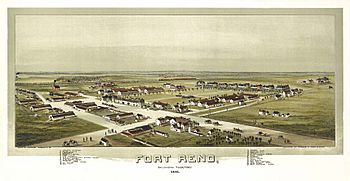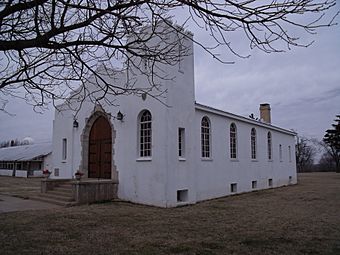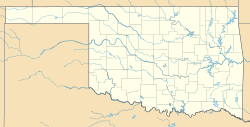Fort Reno (Oklahoma) facts for kids
Quick facts for kids Fort Reno |
|
|---|---|
| Indian Territory / Canadian County, Oklahoma (near El Reno, Oklahoma) |
|

Aerial view of Fort Reno, 1891.
|
|
| Type | Fort |
| Site information | |
| Controlled by | United States |
| Site history | |
| Built | 1874 |
| In use | 1874–1949 |
| Materials | Wood, stone, & brick |
| Battles/wars | Indian Wars on the Southern Plains; Remount Station, World War I & World War II; German Prisoner of War camp, World War II. |
|
Fort Reno
|
|
 |
|
| Nearest city | El Reno, Oklahoma |
| Area | 9.9 acres (4.0 ha) |
| Built | 1874 |
| NRHP reference No. | 70000529 |
| Added to NRHP | June 22, 1970 |
Fort Reno was once an important United States Army base in Oklahoma. It was named after General Jesse L. Reno, a brave soldier who died in the American Civil War. This historic fort is located west of El Reno, Oklahoma.
Contents
The Story of Fort Reno
Why Fort Reno Was Built
Fort Reno started as a temporary camp in July 1874. It was set up near the Darlington Agency to protect people from a Native American uprising. This conflict eventually led to the Red River War. After the war ended, the camp stayed to help control and protect the lands of the Southern Cheyenne and Southern Arapaho. On July 15, 1874, the camp officially became a permanent fort.
Soldiers and Settlers
Soldiers from Fort Reno also worked to manage the "Boomer" and "Sooner" activities. These groups were trying to settle the Unassigned Lands in Oklahoma. One famous group of soldiers stationed here was the Ninth Cavalry, known as the Buffalo Soldiers. The fort's name even inspired the nearby city of El Reno.
Fort Reno After 1907
After Oklahoma became a state in 1907, the army stopped using Fort Reno as a combat post on February 24, 1908. However, it continued as a place where the army kept and trained horses, called a quartermaster remount depot.
During World War II, the fort housed German and Italian prisoners of war. The fort's chapel was even built by some of these prisoners from the Afrika Korps. In 1949, the army left the fort for good. It was then given to the U.S. Department of Agriculture. Today, it is used as a research center for grazing lands. Scientists there study how to manage crops, animal farming, and land in different weather conditions.
Visiting Fort Reno Today
The fort has a cemetery where German and Italian prisoners of war are buried. Pioneer settlers and military personnel also rest there. Ben Clark, a famous scout for generals like George Armstrong Custer, is buried at Fort Reno.
Today, Fort Reno is open to the public. You can visit its center to see old items and learn about the fort's history. Fort Reno was added to the National Register of Historic Places in 1970, recognizing its importance.
Land Claims and History
Original Land Assignment
In 1883, an official order set aside about 9,493 acres (38.42 km2) of land for Fort Reno. This land was part of the Cheyenne and Arapaho reserve and was meant only for military use. Later, in 1892, a presidential announcement by Benjamin Harrison ended most Cheyenne-Arapaho claims to their reserve. However, it did not mention any claims to the land used by Fort Reno.
Efforts to Reclaim Land
For many years, the Cheyenne-Arapaho Tribes have tried to get back the land that the fort used. In 1996, they asked the government for an opinion on their claims. In 1999, the Interior Department agreed that the tribes had a good argument. They believed the tribes had not given up the lands used by the military.
Several politicians have tried to help the Cheyenne-Arapaho Tribes. These include Eni Fa'aua'a Hunkin Faleomavaega, Jr. in 1997 and Senator Daniel Inouye in 2000. In 2005, Oklahoma Senator Jim Inhofe also introduced a bill. This bill would have allowed the government to lease oil and gas resources under the fort. The money from this would help preserve the historic site. However, this bill did not become law.




